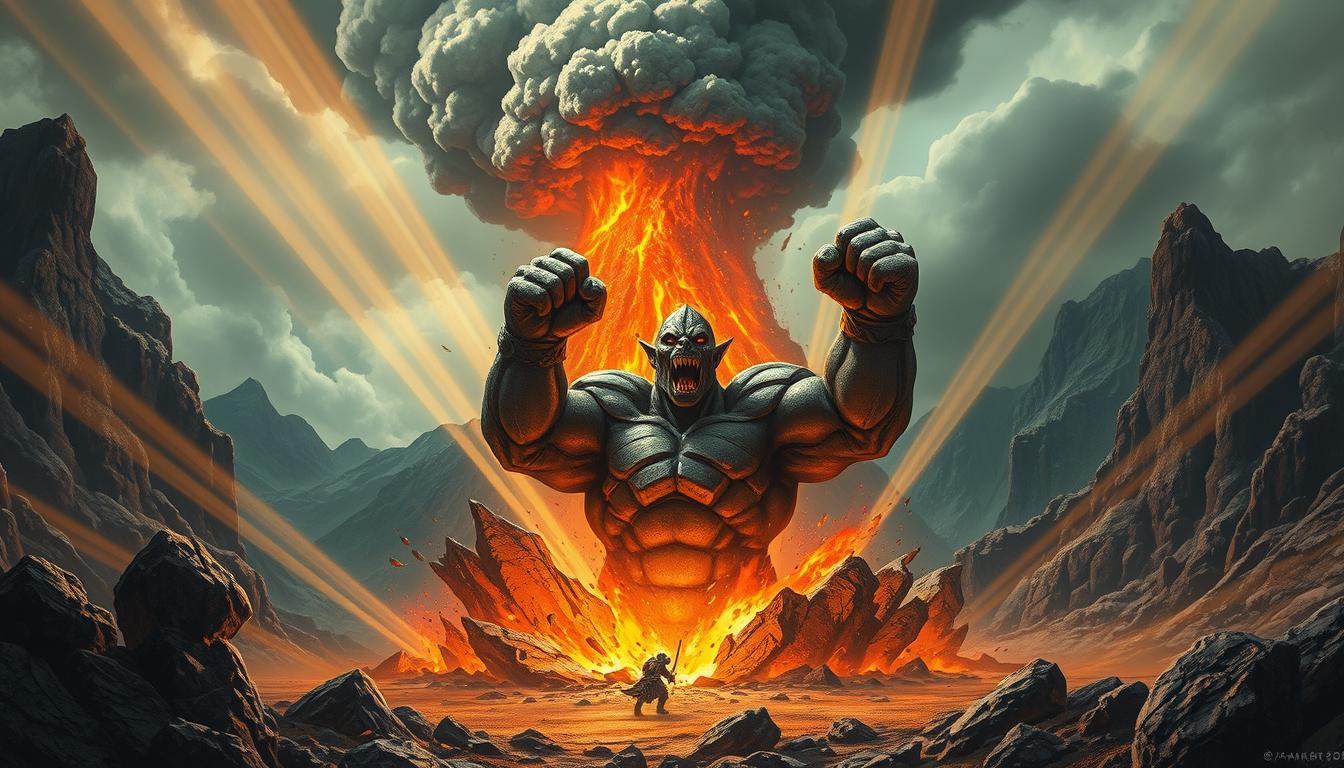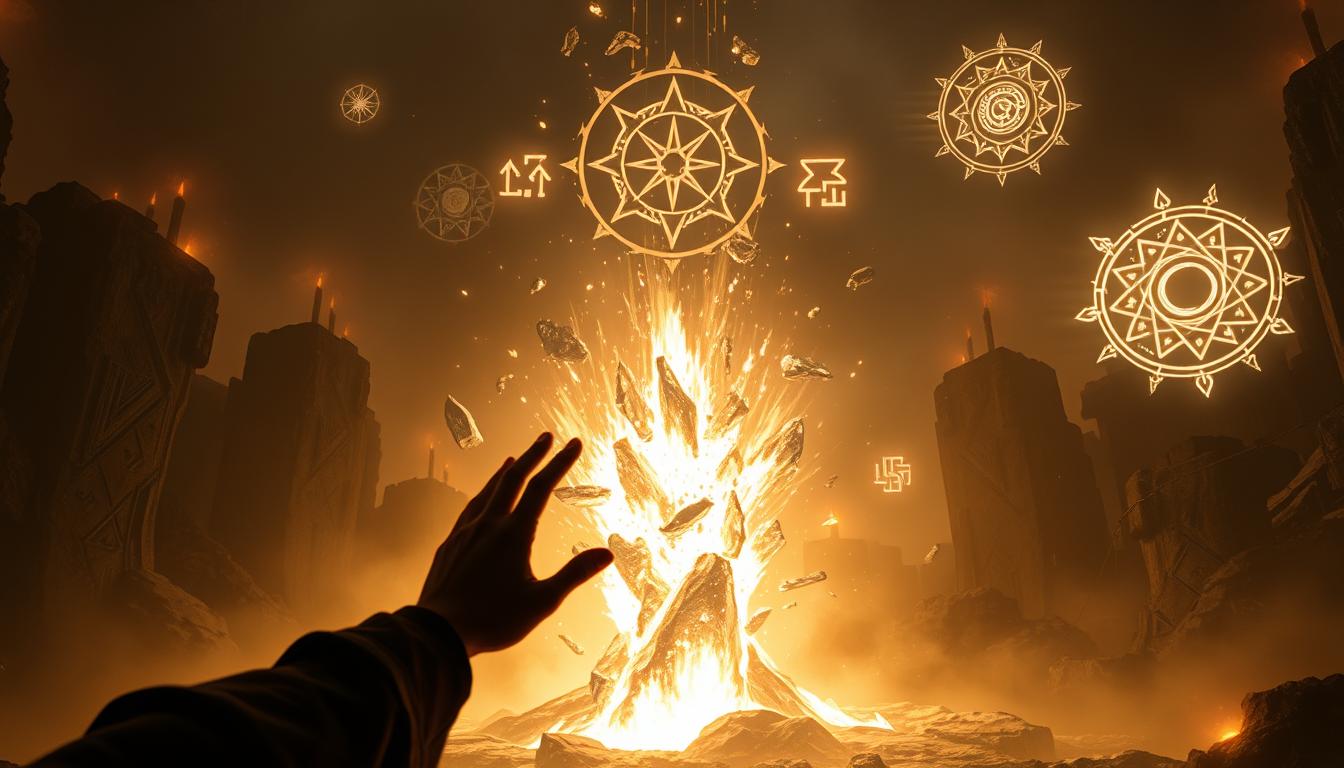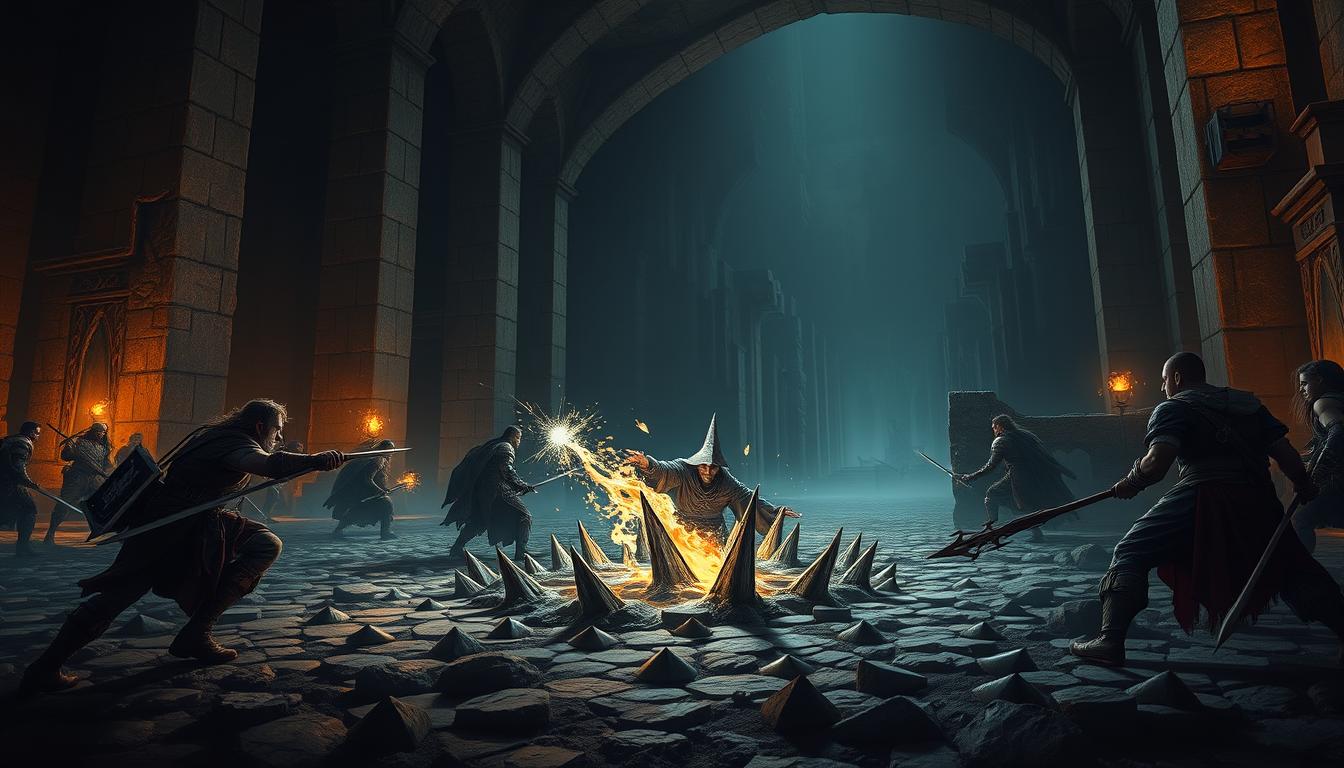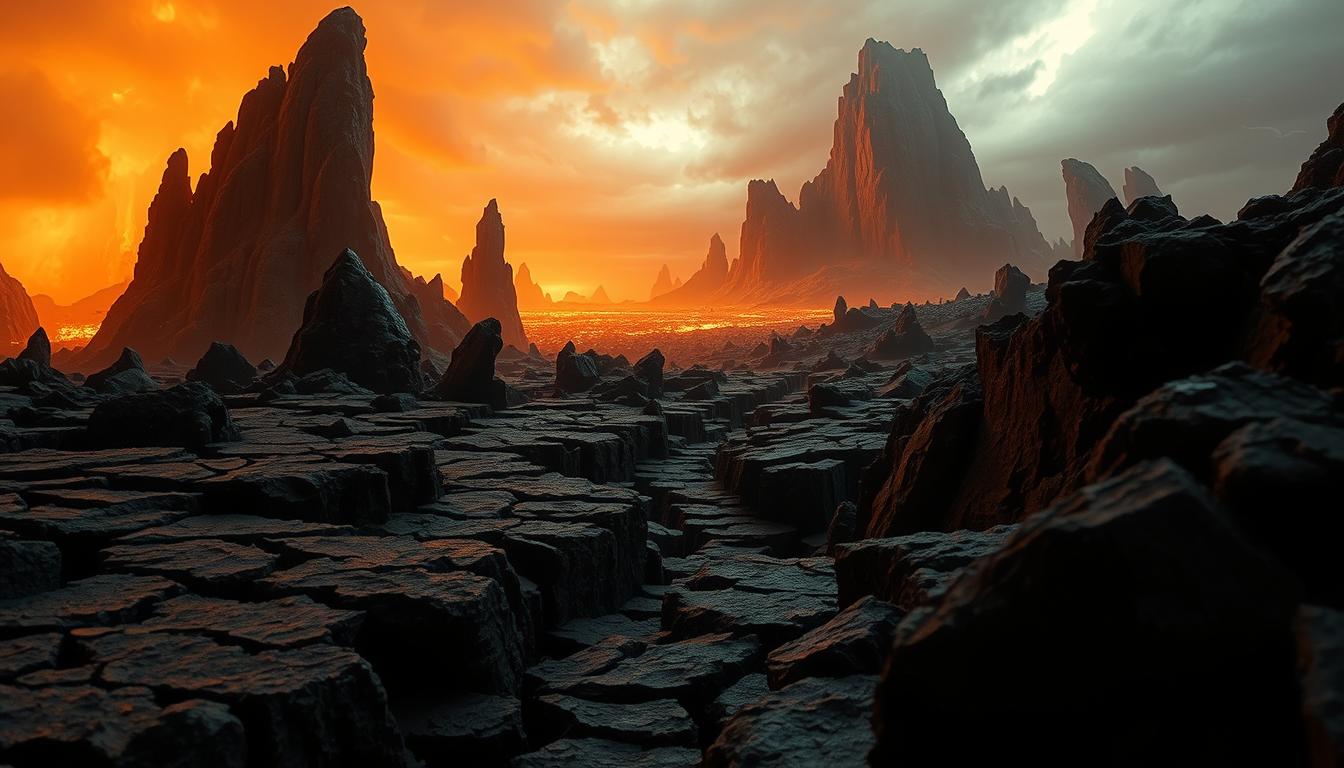Erupting Earth 5e: A Captivating Adventure
Ever wondered how a single spell can turn the tide of battle in Dungeons & Dragons? Erupting Earth 5e isn’t just about raw power—it’s about strategy, creativity, and reshaping the battlefield to your advantage. Whether you’re a Druid, Sorcerer, or Wizard, this 3rd-level spell offers explosive potential.

Why do so many players swear by it? Because it blends damage with control, forcing enemies to rethink their moves. This guide dives into mechanics, tactical uses, and clever tricks to maximize its impact. Ready to make your foes tremble?
Key Takeaways
- Versatile spell for both damage and battlefield control
- Popular among Druids, Sorcerers, and Wizards
- Competes for 3rd-level spell slots but delivers high value
- Encourages creative positioning and tactical play
- Epic flavor that enhances immersion in combat
What Is Erupting Earth 5e?
Few spells pack the punch and battlefield control of this 3rd-level gem. When cast, it tears open the ground in a 20ft cube, dealing 3d12 bludgeoning damage and leaving behind rough terrain. With a 120ft range, it’s perfect for hitting clustered enemies while staying safely distant.
Spell Basics and Overview
This transmutation spell requires verbal, somatic, and material components—a piece of *obsidian*. The effect is instantaneous, but the cracked earth lingers, slowing movement. Unlike *Fireball*, which excels in pure damage, this spell offers control. Enemies must make a Dexterity save or take full damage.
Who Can Cast Erupting Earth?
Three classes unlock this spell at 5th level or higher:
- Druids: Harness nature’s raw power to reshape the battlefield.
- Sorcerers: Amplify its effects with Metamagic for wider range or heightened damage.
- Wizards: Add it to their spellbook for versatile combat strategies.
Each class brings unique synergies. Druids pair it with terrain spells, while Wizards layer it with walls or zones.
How Erupting Earth Works
Cracked earth and flying debris make this spell unforgettable. It’s not just about the initial blast—every ripple effect matters. Here’s what happens when you cast it.
Damage Mechanics and Saving Throws
When the ground erupts, enemies take 3d12 bludgeoning damage. Each creature in the area must roll a Dexterity saving throw. Success halves the damage, but failure means full impact.
Low-Dexterity foes (like armored knights) struggle most. Agile rogues? They’ll often escape lightly. This makes the spell ideal for targeting slow, clustered enemies.
Difficult Terrain Effect Explained
After the explosion, the area becomes difficult terrain. Movement costs double here—forcing enemies to reroute or waste turns. The cracks last until cleared, which takes 1 minute per 5ft square manually.
Compare this to spells like Spike Growth. Both slow enemies, but this one adds immediate damage. Use it to block chokepoints or protect allies from pursuers.
When to Cast Erupting Earth
Timing is everything when unleashing this explosive spell in battle. It shines brightest against clustered enemies but can backfire if misused. I’ve learned to weigh the risks—here’s how to pick your moments.
Ideal Combat Scenarios
This spell devastates melee-heavy groups. Picture five orcs charging your tank—that’s the perfect trigger. The 20ft cube hits multiple enemies, and the rough terrain stalls survivors.
Avoid casting in mixed fights. Archers or spellcasters at the back? You’ll waste half the area. Focus on tight spaces like dungeon corridors or bridges.
Avoiding Friendly Fire
Nothing stings like hitting allies with your own AOE. Always check positions—your rogue flanking? Hold the spell. Use terrain or verbal cues to signal safe zones.
If friendly fire is unavoidable, ask: Is the trade-off worth it? Sometimes, sacrificing a few HP to cripple the enemy is smart. Other times, patience wins.
Maximizing Damage Output
Low-Dexterity foes? They’re practically begging to be crushed by this. To get the *much damage* possible, you’ll need two things: the right targets and smart *spell slot* use. Here’s how to turn this spell into a wrecking ball.

Targeting Low-Dexterity Enemies
Not all enemies dodge equally. Slow, bulky types like ogres or zombies often have Dexterity saves below +2. That means a 61% chance they’ll eat full damage. Prioritize these:
- Ogres: DEX save +0 (hello, 3d12 to the face).
- Zombies: DEX save -2 (they’re basically standing still).
- Armored Knights: Heavy plate = slow reflexes.
Against nimble rogues or spiders? Save your *spell slot*. This spell rewards patience.
Upcasting for Greater Impact
Need *much damage*? Spend higher *slot levels*. Each level above 3rd adds 1d12 damage. Here’s how it scales:
- 4th-level slot: 4d12 (avg 26 damage).
- 5th-level slot: 5d12 (avg 32.5 damage).
Compared to *Fireball*, the scaling is weaker, but the terrain control keeps it competitive. Sorcerers can twist this further—*upcasting* with Empowered Spell Metamagic lets you reroll low damage dice.
Battlefield Control Strategies
Turning the battlefield into your playground requires more than brute force—it demands smart positioning. The terrain becomes your weapon, forcing enemies to fight on your terms. I’ve used this spell to turn hopeless retreats into victorious stands—here’s how.

Creating Chokepoints
Narrow dungeon corridors? Perfect. Cast this spell just behind advancing foes to cut off reinforcements. The 1-minute clearing time means enemies must either:
- Waste turns digging through rubble
- Take long detours while your party picks them off
One game, I blocked a 10ft-wide passage mid-combat. The ogres behind it never reached our squishy wizard—effect achieved.
Slowing Down Pursuers
Running from a dragon? Drop this spell as you flee. Open terrain becomes a maze of cracks, buying precious time. Pair it with readied actions:
- Rogues can shoot arrows as enemies struggle forward
- Clerics can heal while pursuers are delayed
Compared to Spike Growth, this spell deals instant damage while still slowing enemies. Use both for layered control.
Synergies With Other Spells
Spells become twice as deadly when layered together—here’s how to chain them for maximum chaos. Combining effects like *difficult terrain* with damage-over-time turns the battlefield into a deathtrap. I’ve wiped entire encounters using these combos.
Entangle or Web: Lock Them Down
Entangle roots enemies in place, making them easy targets. Cast it first, then drop your spell on the immobilized foes. The action economy works like this:
- Turn 1: Entangle (Concentration). Fails STR save? They’re stuck.
- Turn 2: Your spell hits all targets for full damage.
Web works similarly but targets DEX saves. Pairing both spells ensures something sticks.

Wall of Fire: Double the Pain
Third sources critique the 20ft cube’s size, but Wall of Fire extends the hurt. Cast the wall first, forcing enemies to flee—right into your spell’s area. The damage stacks:
| Spell Combo | Total Avg Damage | Control Effect |
|---|---|---|
| Wall of Fire + Your Spell | 5d8 + 3d12 (avg 44) | Burning + Difficult Terrain |
| Your Spell Alone | 3d12 (avg 19.5) | Difficult Terrain Only |
Concentration is key. Drop the wall first, then let your allies clean up.
Turn-by-Turn Example
Against a monster horde:
- Round 1: Wizard casts Web (DEX save or restrained).
- Round 2: Sorcerer hits trapped foes with your spell. No escape.
- Round 3: Fighter mops up stragglers.
This sequence maximizes damage while minimizing enemy attacks.
Team Play Tips
Great teamwork turns good spells into game-changers. When your party coordinates well, this spell becomes more than damage—it’s a tactical weapon. Here’s how to sync with your team for maximum impact.
Coordinating With Tanks
Tanks can set you up for perfect casts. A smart fighter will herd enemies into tight groups, giving you ideal targets. Watch for these signals:
- Shield raises: Often means “I’m holding them here”
- Stepping backward: Drawing foes into your kill zone
- Delayed attacks: Waiting for your spell before striking
In one battle, our paladin pinned six goblins against a wall. One well-placed cast ended the fight instantly.
Supporting Rogues and Rangers
Slowed enemies are easy prey for rogues and rangers. The difficult terrain gives them:
- +40% chance for Sneak Attack (enemies can’t dodge well)
- Extra shots as foes struggle to close distance
- Time to set traps in the cracked earth
Rangers can layer spells like Spike Growth over your terrain. The damage stacks brutally.
| Team Combo | Damage Increase | Control Bonus |
|---|---|---|
| Your Spell + Rogue | +3d6 Sneak Attack | Locked-down target |
| Your Spell + Ranger | +2d4 Spike Growth | Double movement penalty |
Initiative order matters. Cast right after your tank but before ranged allies. This gives everyone clean shots at slowed targets.
Pros and Cons of Erupting Earth
Every spell has trade-offs—this one balances raw power with tactical flexibility. While it delivers impressive area damage and terrain control, smart casters should consider its limitations before preparing it. I’ve used this spell in dozens of battles, and these are the key factors that determine its effectiveness.
Strengths: Damage and Control
The pros make this spell a battlefield game-changer. Unlike pure damage spells, it combines 3d12 bludgeoning with persistent difficult terrain. This dual effect means:
- No concentration required: The terrain lasts without maintaining focus
- Action economy advantage: One cast delivers immediate and lasting effects
- Versatile positioning: Can block retreats or protect allies
Compared to Fireball, it trades some damage for superior control. Against ground-bound enemies, this often proves more valuable than raw numbers.
Limitations: Spell Slot Cost
The cons become apparent when facing certain foes. Three factors reduce its effectiveness:
- Spell slot hunger: Competes with Counterspell and Haste at 3rd-level
- Flying enemies: Completely bypass the terrain effect
- Scaling issues: Adds only 1d12 per slot level vs Fireball’s 1d6
When I face airborne foes or need maximum damage, I often prepare Lightning Bolt instead. The opportunity cost is real—but when conditions align, few spells match its impact.
| Spell Comparison | Damage (3rd-level) | Control Effect | Best Against |
|---|---|---|---|
| This Spell | 3d12 (19.5 avg) | Difficult terrain | Ground clusters |
| Fireball | 8d6 (28 avg) | None | Spread formations |
| Sleet Storm | None | Prone + Blind | Casters/Archers |
Third-party analyses confirm what I’ve observed—it’s not universally optimal, but when terrain matters more than pure damage, it shines. The choice ultimately depends on your party composition and expected enemies.

Creative Non-Combat Uses
Beyond combat, this spell’s terrain-altering magic unlocks creative problem-solving opportunities. I’ve used it to reshape environments, create instant obstacles, and even assist in archaeological digs. The 1-minute clearing time makes it perfect for temporary alterations.
Terrain Alteration for Exploration
Need to examine buried ruins? The spell can carefully expose layers without damaging artifacts. During one expedition, my party uncovered an ancient altar by clearing precise 5ft squares.
For climbing challenges, the rough terrain actually helps. The cracks create hand holds where smooth walls offered none. Just remember—the effect lasts exactly 1 minute per square, so time your ascents carefully.
Improvised Cover and Barriers
In siege situations, the spell creates instant fortifications. According to DMG object rules, the cracked earth forms barriers with:
| Barrier Type | HP | AC |
|---|---|---|
| Waist-high cover | 15 | 13 |
| Full-height wall | 30 | 15 |
The material component—obsidian—can be reused if collected afterward. I keep fragments in my hand for quick recasting during tense negotiations.
One clever trick? Cast it beneath gate mechanisms to jam them shut. The 1 minute delay gives just enough time to escape or prepare defenses.
Common Questions (And Misconceptions)
Not all bludgeoning damage works the same—this spell has unique properties. I’ve seen players assume it functions like mundane attacks, only to face surprises when resistances come into play. Let’s clear up the confusion.
Magical Bludgeoning Damage Clarified
The damage type here is specifically magical bludgeoning, as confirmed by Jeremy Crawford. This matters because:
- It bypasses most resistances to non-magical attacks
- Treants (with resistance to bludgeoning) still take full damage
- Golems with magic immunity aren’t affected
In one campaign, my party faced a treant guardian. The DM initially ruled for resistance until we referenced the magical bludgeoning distinction—turning a near-disaster into victory.
Environmental Adaptability
This spell interacts uniquely with different terrains. During an Icewind Dale campaign, I discovered:
- Snow and ice surfaces amplify the cracks, extending the difficult terrain radius by 5ft
- Underwater casting creates swirling debris clouds that obscure vision
- Solid rock surfaces may reduce the area but increase damage dice
Third-party tests show varied results—some DMs rule that lava or quicksand negates the effect entirely. Always discuss environmental rulings before crucial battles.
Conclusion: Mastering Erupting Earth
This guide has shown how balancing damage and control can reshape any campaign. Whether you’re blocking choke points or punishing slow enemies, the spell’s versatility shines.
Don’t just stick to the basics—experiment with terrain tricks. Drop it behind fleeing foes or pair it with other spells for layered effects. Every battle offers new ways to outsmart opponents.
Got a wild story about using this magic? Share it at our table! For more tactical tips, join our newsletter below. Now go forth and turn the ground itself into your weapon.